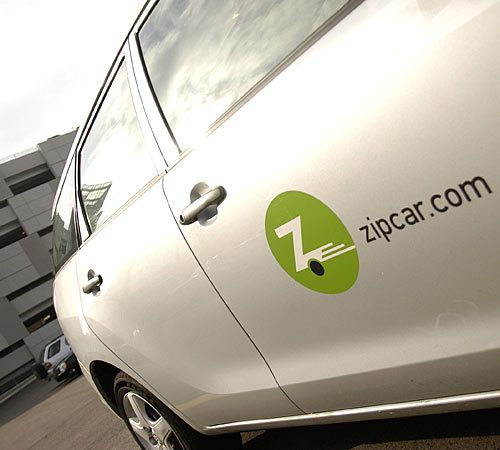New car-sharing program to begin at UI campus in October

A Zipcar resides at the University of Michigan for students to rent. The Zipcar program will be available for UI students in October. Photo courtesy of Max Collins, Michigan Daily
September 9, 2008
Students without a car on campus will soon be able to use one: for limited amounts of time and for a small fee.
The Zipcar program, a car-sharing program known for its sustainability, will begin at the University in October. This program allows students to sign up for an hour or two a day to use a car to drive to places around campus. The car is later returned to where it was picked up and the next student gets to use it.
This four-way deal with Champaign, Urbana, Mass Transit District and the University allows the four groups to share profits and cover costs. MTD maintains the cars and pays for gas and maintenance costs, while the cities and the University cover advertisement and insurance costs, said Pat Pioletti, facilities manager for Urbana.
The program functions with no direct costs to students through fees or tuition, and was created in response to concerns about sustainability and traffic, said Morgan Johnston, transportation demand management coordinator for the University. She also said the main goal of the project is to ease traffic congestion in Campustown and reduce demand for the limited number of parking spaces available.
“We’re trying to encourage the use of alternate modes of transportation,” Johnston said.
Get The Daily Illini in your inbox!
Pioletti said the keys are always left in the car. Students would be able to enter the car through a key card system that the student would swipe to enter the vehicle. This would allow MTD, which takes care of maintenance and gas costs, to charge the user and keep track of who has the vehicle, which will prevent thefts from occurring. Though the car locations are unknown, Pioletti said they would be parked in areas that have high levels of traffic. Also, Champaign, Urbana and Campustown will get two cars each, allowing city residents to use the program as well.
The key to making the program successful is to advertise the program well and make students aware of the program, Pioletti said.
The University, along with the cities, will also work on advertising the program to the students, said Johnston. Though a set plan for advertising has not been established, it will likely involve e-mails and tables on the Quad.
“It’s going to be very well advertised,” Johnston said. “There is going to be a lot of learning about how easy it is.”
Though the program is successful at many campuses, it has failed elsewhere because the program did not take off fast enough.
“It depends on how long it takes for the program to pay for itself,” Pioletti said.
Zipcar is very popular at the University of Michigan, after which they modeled their current plan, Pioletti said. The program has been at the Ann Arbor campus since October of 2006 and has been very successful, said Brian Pawlowski, alternative transportation coordinator for the University of Michigan.
“A lot of students don’t bring their cars to campus now,” Pawlowski said.
The program began at Ann Arbor with six cars, two on each of the University’s three campuses. It has now expanded to 10 cars and 750 college students signed up for the program, Pawlowski said. The money made with the cars easily covers the $1,500 subsidy fee for each car the University of Michigan originally had to pay, and the Parking and Transportation Services division of the university covers gas and maintenance, Pawlowski said.
The cars have also cleared up congestion on the highways and saved students lots of gas money, Pawlowski said. He said he hopes to continue expanding the program at Ann Arbor by bringing more cars and allowing residents to utilize the program more as well.
“We’re always looking to expand,” Pawlowski said.
Carnegie Mellon University in Pittsburgh also has the program. Judy Podraza, a Carnegie Mellon student, uses the program every once in a while to get around campus and said the program has been really popular since it began last year. Podraza pays $7 an hour to use the car in Pittsburgh, but prices at the University are unknown. Many of the cars are also hybrids.
“They have some pretty sick cars,” Podraza said. “I just wish they didn’t come with the Zipcar logo on the side so I could look cool.”
Though advertisement and student interest will ultimately determine the program’s success at the University, Adam Dhedhi, sophomore in LAS, said he believes the program will do well.
“They’re definitely moving in a good direction with this program,” Dhedhi said.






